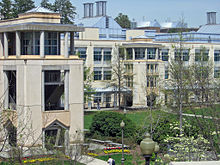Nicholas School of the Environment
| File:Duke-Shield-Nicholas.jpg | |
| Type | Private |
|---|---|
| Established | 1938 — School of Forestry and Environmental Studies 1995 — Nicholas School of the Environment |
| Location | , , |
| Website | www |
The Nicholas School of the Environment is one of ten graduate and professional schools at Duke University and is headquartered on Duke’s main campus in Durham, N.C. A secondary coastal facility is maintained in Beaufort, North Carolina. The Nicholas School is composed of three research divisions: Earth and Ocean Sciences, Environmental Sciences and Policy and Marine Science and Conservation. The current dean of the Nicholas School is Alan Townsend.
The Nicholas School provides a comprehensive multidisciplinary program focused on the relationship of the environment and society to prepare scientists, managers and policymakers to promote the sustainable use of Earth’s resources. The Nicholas School’s program is enhanced by strong collaborations with Duke’s Nicholas Institute for Environmental Policy Solutions and Duke’s eight other graduate and professional schools. The Nicholas School has produced alumni who are leaders in conservation management, industry, government, environmental consulting, and academia. Students emerge from our program as multi-talented problem solvers who are poised in a corporate boardroom, confident on Capitol Hill, and comfortable in natural surroundings.
History
The Nicholas School celebrates its creation date as 1991, but it represents a coming together of three entities that are almost as old as the university itself. Both formed in 1938, the School of Forestry and Environmental Studies and the Duke University Marine Laboratory came together in 1991 to become the School of Environment. Following a $20 million gift from Peter M. and Ginny Nicholas in 1995, the school was named the Nicholas School of the Environment. In 1997, the Department of Geology (formed in 1936) joined the school as the Division of Earth and Ocean Sciences and focuses on a number of areas at the intersection of earth and environmental sciences.


School facilities and technology
The school is headquartered in Environment Hall, a new 70,000-square-foot, five-story glass-and-concrete building, located on Circuit Drive on Duke’s West Campus that incorporates start-of-the-art green features and technologies inside and out. It has been designed to meet or exceed the criteria for LEED Green Building platinum certification, the highest level of sustainability. Duke University’s Environment Hall Received LEED Platinum Certification on October 26, 2015.[1]
The hall houses five classrooms, a 105-seat auditorium, 45 private offices, 72 open office spaces, a 32-seat computer lab, an outdoor courtyard and an environmental art gallery, as well as conference rooms, shared workrooms and common.
Green features range from rooftop solar panels and innovative climate control and water systems, to special windows that moderate light and heat, to an organic orchard and sustainably designed landscaping. The building sits in front of the A Wing of Levine Science Research Center (LSRC) its former home. That wing of the LSRC is currently undergoing renovations to house laboratories and student services oriented offices. The Division of Earth and Ocean Sciences occupies renovated laboratories in the Old Chemistry building on the West Campus with plans to relocate to new space in Environment Hall sometime in 2015. The division maintains state-of-the art facilities for geochemical analysis and climate modeling studies.
The School also holds classes in the Old Chemistry building as well as in the Gross Chemistry Energy Hub on Duke’s main campus.
The Duke University Marine Laboratory is home to the third division of the school, the Marine Science and Conservation division situated on Pivers Island in Beaufort, North Carolina. The current Chair of the Marine Laboratory is Cindy Lee Van Dover. In addition, the Nicholas School uses the Duke Forest, established in 1931 and spanning 7,060 acres, for teaching and research purposes.[2]
Degree programs
As of 2012, the Nicholas School provides educational opportunities for students at the doctoral level (Ph.D.), graduate professional level (Master of Environmental Management and Master of Forestry), and undergraduate level (B.S. and A.B.).
Specialized areas of study offered for the Master of Environmental Management (MEM) degree are as follows:
- Coastal Environmental Management (CEM)
- Ecosystem Science and Conservation (ESC)
- Ecotoxicology and Environmental Health (EEH)
- Energy and Environment (EE)
- Environmental Economics and Policy (EEP)
- Global Environmental Change (GEC)
- Water Resources Management (WRM)
Joint degree programs with Duke University School of Law, Fuqua School of Business, and Sanford School of Public Policy are also available to enrolled students at the Nicholas School.[3] Other concurrent degree programs include the Master of Arts in Teaching (MA) administered through the Graduate School of Duke University, Master of Engineering Management Program (MEMP) at the Pratt School of Engineering, and selected graduate degrees offered at the University of North Carolina at Chapel Hill.
See also
References
- ^ https://nicholas.duke.edu/about/news/duke-university%E2%80%99s-environment-hall-receives-leed-platinum-certification
- ^ "Duke Forest: About". Duke University. Retrieved 30 December 2012.
- ^ "Concurrent Degree Programs". Duke University. Retrieved 30 December 2012.
External links
- Nicholas School of the Environment
- Duke Marine Lab
- Nicholas Institute for Environmental Policy Solutions
- Duke University

